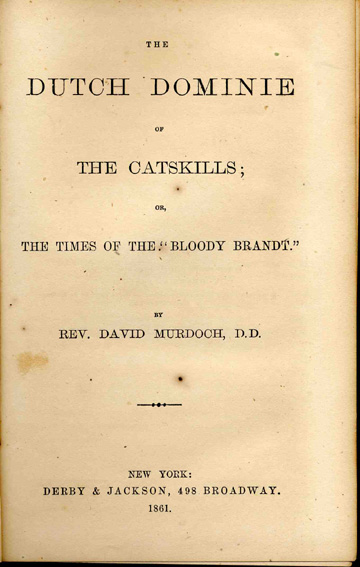The Dutch Dominie of the Catskills<br>By David Murdoch
- by Bruce E. McKinney

The Dutch Dominie of the Catskills... published in 1861
In reading “The Dutch Dominie of the Catskills...,” a work of fiction first printed in 1861, I encountered an interesting account of the Revolutionary War era in the Catskill mountain region. I also encountered a very harsh presentation of Blacks. I then sought to learn more about the writer, the Rev. David Murdoch, to try to understand if his presentation of Blacks was motivated by honest feelings or deep prejudice. What I uncovered is a complex weave of circumstantial evidence that is included here for those who may wish to pursue this inquiry to its last word. Clearly, the true feelings and motivations are not easily discerned for even a hundred years later both the church he pastored and the church he then helped found continued to argue over these very issues.
The suggested sequence of reading is this.
- The Dutch Dominie of the Catskills – a review and commentary (this piece)
- The Doctrine of Caiaphas by Rev. David Murdoch. This is his account of his nine and a half years as Pastor of the First Presbyterian Church in Elmira (1851-1861);
- The obituary of Rev. Murdoch as published in the Elmira Gazette, July, 1861;
- Two obituaries of Tracy Beadle, the man who opposed Rev. Murdoch;
- Excerpts from various local documents that cast some additional light.
I issue you a fair warning. This is a complex issue. Much of the writing is very well executed. In total, but not including the book I first review, these pieces run to more than 21,000 words. The full text of the book will be posted if there is an interest to do so.
The Dutch Dominie of the Catskills; Or, The Times of The "Bloody Brandt,” covers a brief period during the Revolutionary War – the fall of 1778, in the Catskill Mountain region of upstate New York. It is a work of historical fiction right from the get-go and yet manages to convey an historical honesty that is convincing. This book is written by the Rev. David Murdoch and first published in 1861 before being reprinted in 1865 under the altered title: The Royalist’s Daughter and the Rebels or, the Dutch Dominie of the Catskills. A Tale of the Revolution. It is really a series of interconnected stories of the local population, the Indians, their relationship to the British and the life and drama of that time. It is not that the events are entirely true but that they seem real. This account sensitively portrays the Dutch, is reasonably even handed with the Indians and very harsh on the Blacks. The most surprising and important element in the book is its casual assumption of slaves as less than human. Neither do I recall any Blacks in this book that are not slaves.
I have concluded that the Rev. Dr. Murdoch was certainly an intellectually gifted and conservative man who was incapable of applying varnish. He preferred the natural wood. I therefore believe his account of life, at the time of Revolution, is what he believed it to have been. And while his description of the Black experience at that time is by no stretch the theme of this book, it is a compelling picture of 18th century racial views and a cautionary tale for racial relations today.